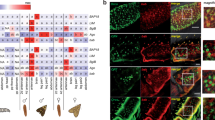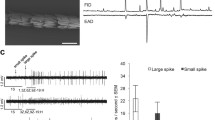Abstract
The evolution of male moth responses to pheromone blends may be constrained by a trade-off between two response traits: sensitivity and breadth of response. Population genetic simulations predict that if sensitivity and breadth of response are negatively correlated (i.e., a trade-off exists), then selection will favor males with narrow response phenotypes and high sensitivity. Although sensitivity–breadth of response trade-offs are generally assumed to exist and are implicit to the shape of male preference function, this study is the first to provide empirical support measuring behavior at the level of the individual. Previous studies with the cabbage looper, Trichoplusia ni, have documented the existence of a mutant pheromone strain. While mutant females produce a pheromone blend significantly different from wild-type females, mutant males respond equally to the wild-type and mutant pheromone blends. This study used wind tunnel bioassays to document that relative to wild-type males, mutant males had broader response profiles but lower pheromone sensitivity. While wild-type male responses were highest to the wild-type pheromone blend, mutant males did not discriminate among pheromone blends. These results are consistent with a trade-off between breadth of response and sensitivity. Pure wild-type and mutant lines were crossed and hybrid males assayed. Both hybrid types (maternal wild-type and maternal mutant hybrids) responded similarly. Hybrid males had response profiles similar to wild-type males and the reduced sensitivity observed in mutant males. These results suggest a possible hybrid disadvantage and a putative mechanism for reinforcement of male pheromone response traits.



Similar content being viewed by others
References
Allison, J. D., and Cardé, R. T. 2006. Heritable variation in the sex pheromone of the almond moth, Cadra cautella. J. Chem. Ecol. 32:621–641.
Allison, J. D., and Cardé, R. T. 2007. Bidirectional selection for novel pheromone blend ratios in the almond moth, Cadra cautella. J. Chem. Ecol. 33:2293–2307.
Allison, J. D., and Cardé, R. T. 2008. Male pheromone blend preference function measured in choice and no-choice wind-tunnel trials with Cadra cautella. Anim. Behav. 75:259–266.
Baker, T. C., Meyer, W., and Roelofs, W. L. 1981. Sex-pheromone dosage and blend specificity of response by oriental fruit moth males. Entomol. Exp. Appl. 30:269–279.
Bentsen, C. L., Hunt, J., Jennions, M. D., and Brooks, R. 2006. Complex multivariate sexual selection on male acoustic signaling in a wild population of Teleogryllus commodus. Am. Nat. 167:E102–E116.
Butlin, R. K. 1987. Speciation by reinforcement. Trends Ecol. Evol. 2:8–13.
Butlin, R. K., and Ritchie, M. G. 1989. Genetic coupling in mate recognition systems: what is the evidence? Biol. J. Linn. Soc. 37:237–246.
Butlin, R. K., and Trickett, A. J. 1997. Can population genetic simulations help to interpret pheromone evolution?, pp. 548–562, in R. T., Cardé, A. K., and Minks (eds.). Insect Pheromone Research: New Directions Chapman and Hall, New York.
Cardé, R. T. 1986. The role of pheromones in reproductive isolation and speciation of insects, pp. 303–317, in M. D., and Huettel (eds.). Genetics of Invertebrate Behavior: Progress and ProspectsPlenum, New York.
Cardé, R. T., and Charlton, R. E. 1984. Olfactory sexual communication in Lepidoptera: strategy, sensitivity and selectivity, pp. 241–265, in T. Lewis (ed.). Insect Communication Academic, London.
Cardé, R. T., and Haynes, K. F. 2004. Structure of the pheromone communication channel in moths, pp. 283–332, in R. T., Cardé, K. F., and Haynes (eds.). Advances in Insect Chemical Ecology. Cambridge University Press, Cambridge.
Collins, R. D., and Cardé, R. T. 1985. Variation in and heritability of aspects of pheromone production in the pink bollworm moth, Pectinophora gossypiella (Lepidoptera: Gelechiidae). Ann. Entomol. Soc. Am. 78:229–234.
Collins, R. D., and Cardé, R. T. 1989. Selection for altered pheromone-component ratios in the pink bollworm moth, Pectinophora gossypiella (Lepidoptera: Gelechiidae). J. Insect Behav. 2:609–621.
Collins, R. D., and Cardé, R. T. 1990. Selection for increased pheromone response in the male pink-bollworm, Pectinophora gossypiella (Lepidoptera: Gelechiidae). Behav. Genet. 20:325–331.
Collins, R. D., Rosenblum, S. L., and Cardé, R. T. 1990. Selection for increased pheromone titre in the pink bollworm moth, Pectinophora gossypiella (Lepidoptera: Gelechiidae). Physiol. Entomol. 15:141–147.
Evenden, M. L., and Haynes, K. F. 2001. Potential for the evolution of resistance to pheromone-based mating disruption tested using two pheromone strains of the cabbage looper, Trichoplusia ni. Entomol. Exp. Appl. 100:131–134.
Evenden, M. L., Spohn, B. G., Moore, A. J., Preziosi, R. F., and Haynes, K. F. 2002. Inheritance and evolution of male response to sex pheromone in Trichoplusia ni (Lepidoptera: Noctuidae). Chemoecology 12:53–59.
Gemeno, C., Moore, A. J., Preziosi, R. F., and Haynes, K. F. 2001. Quantitative genetics of signal evolution: a comparison of the pheromonal signal of two populations of the cabbage looper, Trichoplusia ni. Behav. Genet. 31:157–165.
Groot, A. T., Horovitz, J. L., Hamilton, J., Santangelo, R. G., Schal, C., and Gould, F. 2006. Experimental evidence for interspecific directional selection on moth pheromone communication. Proc. Natl. Acad. Sci. U. S. A. 103:5858–5863.
Hansson, B. S., Löfstedt, C., and Roelofs, W. L. 1987. Inheritance of olfactory response to sex pheromone components in Ostrinia nubilalis. Naturwissenchaften 74:497–499.
Hansson, B. S., Löfstedt, C., and Foster, S. P. 1989. Z-linked inheritance of male olfactory response to sex pheromone components in two species of tortricid moths, Ctenopseustis obliquana and Ctenopseustis sp. Entomol. Exp. Appl. 53:137–145.
Haynes, K. F., and Hunt, R. E. 1990. A mutation in pheromonal communication system of cabbage looper moth, Trichoplusia ni. J. Chem. Ecol. 16:1249–1257.
Hunt, R. E., and Haynes, K. F. 1990. Periodicity in the quantity and blend ratios of pheromone components in glands and volatile emissions of mutant and normal cabbage looper moths, Trichoplusia ni. J. Insect Physiol. 36:769–774.
Hunt, R. E., Zhao, B., and Haynes, K. F. 1990. Genetic aspects of interpopulational differences in the pheromone blend of the cabbage looper moth, Trichoplusia ni. J. Chem. Ecol. 16:2935–2946.
Klun, J. A., and Maini, S. 1979. Genetic basis of an insect chemical communication system: the European corn borer. Environ. Entomol. 8:423–426.
Lande, R. 1979. Quantitative genetic analysis of multivariate evolution applied to brain: body area allometry. Evolution 33:402–416.
Lande, R., and Arnold, S. J. 1983. The measurement of selection on correlated characters. Evolution 37:1210–1226.
Linn, C. E., and Roelofs, W. L. 1985. Response specificity of male pink bollworm moths to different blends and dosages of sex pheromone. J. Chem. Ecol. 11:1583–1590.
Linn, C. E. Jr., Campbell, M. G., and Roelofs, W. L. 1987. Pheromone components and active spaces: what do moths smell and where do they smell it? Science 237:650–652.
Liu, Y. -B., and Haynes, K. F. 1994. Evolution of behavioral responses to sex pheromone in mutant laboratory colonies of Trichoplusia ni. J. Chem. Ecol. 20:231–237.
Löfstedt, C., and Kozlov, M. 1997. A phylogenetic analysis of pheromone communication in primitive moths, pp. 473–489, in R. T., Cardé, A. K., and Minks (eds.). Insect Pheromone Research: New Directions. Cambridge University Press, Cambridge.
McElfresh, J. S., and Millar, J. G. 2001. Geographic variation in the pheromone system of the saturniid moth Hemileuca eglanterina. Ecology 82:3505–3518.
Miller, J. R., and Roelofs, W. L. 1978. Sustained-flight tunnel for measuring insect responses to wind-borne sex pheromones. J. Chem. Ecol. 4:187–198.
Phelan, P. L. 1997. Evolution of mate-signaling in moths: phylogenetic considerations and predictions from the asymmetric tracking hypothesis, pp. 240–256, in J. C., Choe, B. J., and Crespi (eds.). The Evolution of Mating Systems in Insects and Arachnids. Cambridge University Press, New York.
Reznick, D., Nunney, L., and Tessier, A. 2000. Big houses, big cars, superfleas and the cost of reproduction. Trends Ecol. Evol. 15:421–425.
Roelofs, W. L. 1978. Threshold hypothesis for pheromone perception. J. Chem. Ecol. 4:685–699.
Roelofs, W. L., and Comeau, A. 1969. Sex pheromone specificity: taxonomic and evolutionary aspects in Lepidoptera. Science 165:398–399.
Roelofs, W. L., Glover, T., Tang, X., Sreng, I., Robbins, P., Eckenrode, C., Löfstedt, C., Hansson, B. S., and Bengtsson, B. O. 1987. Sex pheromone production and perception in European corn borer moths is determined by both autosomal and sex-linked genes. Proc. Natl. Acad. Sci. U. S. A. 84:7585–7589.
Roff, D. A. 1992. The Evolution of Life Histories. Chapman and Hall, London.
Sas 1996. SAS User’s Guide: Basics. 6.03th edn.SAS Institute Inc, Cary, NC.
Schek, A. L., Groot, A. T., Ward, C. M., Gemeno, C., Wang, J., Brownie, C., Schal, C., and Gould, F. 2006. Genetics of sex pheromone blend differences between Heliothis viriscens and Heliothis subflexa: a chromosome mapping approach. J. Evol. Biol. 19:600–617.
Shorey, H. H., and Hale, R. L. 1965. Mass-rearing of the larvae of nine noctuid species on a simple artificial medium. J. Econ. Entomol. 58:522–524.
Sreng, I., Glover, T., and Roelofs, W. 1989. Canalization of the redbanded leafroller moth sex pheromone blend. Arch. Insect Biochem. Physiol. 10:73–82.
Stearns, S. C. 1992. The Evolution of Life Histories. Oxford University Press, Oxford.
Svensson, G. P., Ryne, C., and Löfstedt, C. 2002. Heritable variation of sex pheromone composition and the potential for evolution of resistance to pheromone-based control of the Indian meal moth, Plodia interpunctella. J. Chem. Ecol. 28:1447–1461.
Tumlinson, J. H., Yonce, C. E., Doolittle, R. E., Heath, R. R., Gentry, C. R., and Mitchell, E. R. 1974. Sex pheromones and reproductive isolation of the lesser peachtree borer and the peachtree borer. Science 185:614–616.
Zhu, J., Chastain, B. C., Spohn, B. G., and Haynes, K. F. 1997. Assortative mating in two pheromone strains of the cabbage looper moth, Trichoplusia ni. J. Insect Behav. 10:805–808.
Acknowledgments
We are grateful to B. Chastain for reliable and invaluable technical assistance and to Drs. C. Gemeno and M. Evenden for comments and discussions. The research was supported by the Kentucky Agricultural Experiment Station and a competitive grant from the USDA, Cooperative State Research and Extension Service (97-35302-4324).
Author information
Authors and Affiliations
Corresponding author
Rights and permissions
About this article
Cite this article
Hemmann, D.J., Allison, J.D. & Haynes, K.F. Trade-Off Between Sensitivity and Specificity in the Cabbage Looper Moth Response to Sex Pheromone. J Chem Ecol 34, 1476–1486 (2008). https://doi.org/10.1007/s10886-008-9546-8
Received:
Revised:
Accepted:
Published:
Issue Date:
DOI: https://doi.org/10.1007/s10886-008-9546-8




